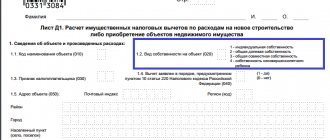We separate movable property from immovable property
It would seem that it could be difficult to qualify an object - whether it belongs to movable or immovable property. But, as practice shows, accountants face certain difficulties. To avoid mistakes, we recommend that you read the letter of the Federal Tax Service of Russia dated October 1, 2018 No. BS-4-21/ [email protected] In it, tax service specialists explained what criteria companies and local tax authorities should follow in order to understand what type of property (movable or immovable) is a fixed asset for property tax purposes.
The procedure for imposing property tax depends on whether the object is movable or immovable property.
Thus, movable property accepted for registration as fixed assets from January 1, 2013 (except for those received during reorganization and liquidation, as well as from interdependent persons) is exempt from taxation (clause 25 of Article 381 of the Tax Code of the Russian Federation). Let us remind you that from January 1, 2020, this benefit is applied in the territory of a constituent entity of the Russian Federation if it adopts the corresponding law (clause 1 of Article 381.1 of the Tax Code of the Russian Federation). And from January 1, 2020, movable property will not be recognized as an object of taxation at all. Only real estate will be subject to tax (clause 1 of Article 374 of the Tax Code of the Russian Federation as amended by Federal Law No. 302-FZ of August 3, 2018).
This is important to know: What documents should the owner of the apartment have?
Thus, it is important for a company to clearly understand which property is classified as movable and which is classified as immovable.
What is movable and what is immovable
The Tax Code does not contain definitions of the concepts of movable and immovable property. Therefore, in accordance with paragraph 1 of Art. 11 of the Tax Code of the Russian Federation, they should be used in the meaning in which they are used in other areas of legislation.
What real estate is is stated in paragraph 1 of Art. 130 Civil Code of the Russian Federation. According to this norm, real estate includes land plots, subsoil plots and everything that is firmly connected to the land, that is, objects whose movement without disproportionate damage to their purpose is impossible, including buildings, structures, and unfinished construction projects. Also real estate are:
— aircraft and sea vessels, inland navigation vessels subject to state registration;
- residential and non-residential premises intended to accommodate transport vehicles, parts of buildings or structures (car spaces), if the boundaries of such premises, parts of buildings or structures are described in the manner established by the legislation on state cadastral registration.
In paragraph 1 of Art. 130 of the Civil Code of the Russian Federation establishes that other property may also be classified as immovable property by law.
Things that are not related to real estate are recognized as movable property (clause 2 of article 130 of the Civil Code of the Russian Federation).
Basic data
The following data is entered into the Unified State Register of Real Estate (USRE) as basic information about the property:
- view;
- cadastral number;
- date of registration;
- location description;
- previously assigned code;
- cessation of existence;
- square;
- specifications;
- degree of readiness (for unfinished construction projects);
- number of floors;
- year of commissioning;
- external wall material.
Building, structure, premises
As mentioned above, buildings, structures, as well as residential and non-residential premises are classified as real estate. In the commented letter, the Federal Tax Service of Russia explained that when defining the concepts of “building”, “structure”, “premises” one should be guided by the Federal Law of December 30, 2009 No. 384-FZ “Technical Regulations on the Safety of Buildings and Structures” (hereinafter referred to as Law No. 384- Federal Law).
So, according to sub. 6 paragraph 2 art. 2 of Law No. 384-FZ, a building is considered to be the result of construction, which is a volumetric construction system having above-ground and (or) underground parts, including premises, networks and engineering support systems and intended for living and (or) activities of people, accommodation production, storage of products or keeping animals.
Please note: in the letter of the Ministry of Industry and Trade of Russia dated March 23, 2018 No. OV-17590/12 (communicated by the letter of the Federal Tax Service of Russia dated March 28, 2018 No. BS-4-21 / [email protected] ) it is said that the buildings include communications inside the buildings necessary for their operation:
- heating system, including boiler installation for heating (if the latter is located in the building itself);
— internal water supply, gas and sewerage networks with all devices and equipment;
— internal network of power and lighting electrical wiring with all lighting fixtures;
— internal telephone and alarm networks;
— ventilation devices for general sanitary purposes;
- lifts and elevators.
A structure is understood as the result of construction in the form of a volumetric, planar or linear building system, having ground, above-ground and (or) underground parts, consisting of load-bearing, and in some cases, enclosing building structures and intended for performing various types of production processes, storing products, temporary stay of people, movement of people and goods (subclause 23, clause 2, article 2 of Law No. 384-FZ). And a room is a part of the volume of a building or structure that has a specific purpose and is limited by building structures (subclause 14, clause 2, article 2 of Law No. 384-FZ).
The Russian Ministry of Finance agrees that when determining the composition of real estate related to buildings and structures, in order to calculate property tax, one must be guided by Law No. 384-FZ.
Registration of an object as a sign of real estate
Article 131 of the Civil Code of the Russian Federation provides that ownership and other proprietary rights to real estate are subject to state registration. The question arises: does property belong to real estate if the rights to it are not registered?
Based on this, tax authorities provided the following algorithm of actions to identify the grounds for classifying a property as real estate.
First of all, you need to establish whether there is a record about the object in the Unified State Register of Real Estate. If there is, then such an object is recognized as real estate.
If there is no entry in the Unified State Register of Real Estate, you need to check whether there are grounds confirming the strength of the connection between the object and the ground and the impossibility of moving the object without disproportionate damage to its purpose. For example, in relation to capital construction projects, documents of technical accounting or technical inventory, permits for construction and (or) for putting the facility into operation (if necessary), design documentation, expert opinions or other documents that contain information about the relevant characteristics are subject to examination. objects, etc.
Tax officials also drew attention to the Resolution of the Presidium of the Supreme Arbitration Court of the Russian Federation dated September 24, 2013 No. 1160/13, which states that, within the meaning of civil legislation, rights can be registered only in relation to those things that, having signs of real estate, are capable of acting in civil circulation as individual objects of civil rights.
AN OBJECT
OBJECT (Late Lat. Objectum - subject, from Lat. objicio - throw forward, oppose) - that to which the activity (real and cognitive) of the subject [SUBJECT] is directed. An object is not identical to objective reality: firstly, that part of the latter that has not entered into relation to the subject is not an object; secondly, states of consciousness can also be objects. There are different types of objects and, accordingly, different types of subject-object relationships. An object can be a physical thing that exists in space and time, an objectively real situation. This may be the subject's own body. Objects can be states of consciousness of the subject and even his Self as a whole. Other people, their consciousness, as well as cultural objects (including texts) and their inherent meanings can act in this capacity.
The activity of the subject necessarily presupposes an object external to it. Otherwise, it is impossible, just as the subject itself becomes impossible. Therefore, the opposition of two types of relations, subject-object and subject-subject, often found in Russian philosophical literature, is in fact without foundation. It is based on the wrongful identification of an object with a physical thing. In reality, anything that exists can become an object. At the same time, to understand the basic characteristics of consciousness, cognition and activity, it is important to keep in mind the fundamental fact that the object is always external to the subject and does not merge with it. This externality occurs both when the subject deals with the states of his own consciousness, his I, and when he enters into relationships with other subjects. So, for example, understanding [UNDERSTANDING] another person, which presupposes the ability to take the point of view of this other, as if to experience his state from the inside (what is usually considered a classic case of subject-subject relations), can only be successful if the subject does not merge with the states of someone else’s consciousness, just as even the subject to whom these states belong cannot completely merge with them, and does not cease to perceive the other from the outside, possessing the “excess of vision” that MMBakhtin wrote about. At the same time, it is important to emphasize that the relationship between subject and object is not a relationship between two different worlds, but only two poles within a certain unity. The removal of the opposition between the subjective and the objective as two independent worlds does not mean the removal of subject-object relations.
Often the term “object” is used in philosophy outside the context of its relationship to the subject, but simply in the sense of an object. Thus, in the philosophy of science, along with empirical objects, theoretical objects are also distinguished. The latter receive different interpretations. From the point of view of instrumentalism, these are only conventionally accepted ways of reasoning about empirical objects. From the point of view of realism, some theoretical objects to which properties of spatial and temporal localization are attributed (such as atoms, electrons, quarks, etc.) actually exist. It is generally accepted that such theoretical objects, which are called ideal (material point, ideal solid body, etc.), do not really exist, but are introduced into the theory as ways of studying certain phenomena in their pure form. A special position is occupied by the so-called. abstract objects considered in modern logic, in particular in type theory. According to this theory, concrete objects are individuals and as such belong to type zero; the type of abstract objects is higher than zero (first, second, etc.). In accordance with this, abstract objects can act as classes of individuals, classes of classes of individuals, etc. or as properties of individuals, properties of properties, etc., as relations of individuals, relations of relations, etc. One type of abstract object is, in particular, numbers. Abstract objects are not identical to theoretical ones, because theoretical objects of factual knowledge belong, as a rule, to the zero level, i.e. concrete (such as atoms and electrons, but also ideal solids).
V.A. Lektorsky
Source: New Philosophical Encyclopedia on Gufo.me
Meanings in other dictionaries
- Object - Geometric - see Geometric objects theory. Mathematical Encyclopedia
- object - object I m. 1. The external world existing outside of us and independently of our consciousness, which is the subject of knowledge, practical influence of the subject (in philosophy). 2. A person, phenomenon, object at which any activity is directed. Explanatory Dictionary by Efremova
- object - OBJECT, object, male. (Latin objectum - Subject) (book). 1. That which exists outside of us and independently of us, the external world (philosophy). “The coincidence of thought with an object is a process.” Lenin. 2. An object, something external towards which human activity is directed. Ushakov's Explanatory Dictionary
- object - That which can be individually described and examined. An object may be, for example, an activity or process, a product, an organization, a system or an individual, or any combination of these. [78] Construction terminology
- object - 1. an object, a phenomenon towards which any activity is directed; 2. enterprise, institution, as well as everything that is the place of any activity. Great Accounting Dictionary
- object - see: cut an object Explanatory dictionary of Russian argot
- object - orf. object, -a Lopatin's Spelling Dictionary
- object - (lat. objectum - subject). An object that has some relationship with the action. Expressed grammatically by addition. Rosenthal Dictionary of Linguistic Terms
- object - Borrow. in the 16th century from Polish lang., where objekt < lat. objectum, suf. derived from objicere “to throw forward, towards.” Noun subject: word-formation tracing paper of the 18th century. lat. words. Shansky Etymological Dictionary
- object - Latin - objectum (object). The word “object” came into Russian in the 16th century, but became widespread only at the beginning of the 18th century. This word was borrowed from the Polish language, where it came from Latin. Etymological Dictionary of Semenov
- object - (< lat. Dictionary of linguistic terms Zherebilo
- Object - OBJECT. 1. In a judgment - an object or person to which the action of another object applies; for example, such O. are concepts expressed by indirect cases of nouns without prepositions or with prepositions in combinations such as chopping wood... Dictionary of literary terms
- object - OBJECT (late Lat. objectum - subject; from Lat. objicio - throw forward, oppose) - that to which the activity (real and cognitive) of the subject is directed. Encyclopedia of Epistemology and Philosophy of Science
- object - Borrowing from Latin, where objectum is derived from objicere - “to throw towards.” In addition, in the Russian language there is a word that is a translation of the Latin objectum - object. Krylov's etymological dictionary
- OBJECT - (ECONOMIC) (from Latin objectum) enterprises, organizations, means and factors of production, elements of the social sphere, characterized as an object in which economic activity is concentrated or directed... Economic dictionary of terms
- object - OBJECT, a, m. 1. In philosophy: that which exists outside of us and independently of our consciousness, a phenomenon of the external world. 2. A phenomenon, an object towards which someone’s direction is directed. activity, chyon. attention (book). O. study, description. O. fishing. Ozhegov's Explanatory Dictionary
- object - noun, m., used. compare often (not) what? object, why? object, (see) what? object, what? object, about what? about the object; pl. What? objects, (no) what? objects, why? objects, (see) what? objects, what? objects, about what? about objects... Dmitriev's Explanatory Dictionary
- object - Object, objects, object, objects, object, objects, object, objects, object, objects, object, objects Zaliznyak's Grammar Dictionary
- object - Object/. Morphemic-spelling dictionary
- object - A phenomenon, an object, a person to whom someone’s activity, someone’s attention is directed and Explanatory Dictionary of Translation Studies / L.L. Nelyubin. — 3rd ed., revised. - M.: Flinta: Nauka, 2003 Explanatory translation dictionary
- object - OBJECT a, m. objet m. In our philosophical language, still so poor in definitions and technical expressions, the following words have recently begun to be used: subject, subjectivity, object, objectivity... Dictionary of Gallicisms of the Russian language
- object - OBJECT -a; m. [from lat. objectum - subject] 1. Philosophy. That which exists outside of us and independently of us; the external world, reality, towards which the subject’s objective-practical and cognitive activity is directed. World of objects. O. in yourself. Kuznetsov's Explanatory Dictionary
- object - noun, number of synonyms... Dictionary of synonyms of the Russian language
- Object - I Object (Late Lat. objectum - subject, from Lat. objicio - throw forward, oppose) that which opposes the subject in his objective-practical and cognitive activity. Great Soviet Encyclopedia
- OBJECT - OBJECT (from Latin objectum - subject) - English. object; German Object. 1. An object, phenomenon, process or their individual aspects that exist in reality. 2. Subject, phenomenon, process, which is aimed at. activity, thought, feeling, etc. Sociological Dictionary
- object - -a, m. 1. Phenomenon, object, person towards which someone’s focus is directed. activity, smb. attention, etc. Object of observation. Object of study. □ [Razuvaev] rented groves and sent barges with firewood to the city. Small academic dictionary
- object - OBJECT - SUBJECT Objective - subjective (see) objective - subjective (see) objectivity - subjectivity (see) What are the natural foundations of philosophy? I and not-I, the inner world and the outer world, subject and object. Chaadaev. Passages and aphorisms. Dictionary of antonyms of the Russian language
- object - Object, m. [Latin. objectum – subject] (book). 1. That which exists outside of us and independently of us, the external world (philosophy). 2. An object, something external towards which human activity is directed. Object of study. Large dictionary of foreign words
- OBJECT - OBJECT - in linguistics - the name of an object or person to which an action expressed by a verb is directed (contrasted with the subject of the action); the same as the addition of a verb and a verbal noun. OBJECT (from Lat. Big Encyclopedic Dictionary
- object - OBJECT m. Latin. object opposite sex subject or self. The lens is the glass of the telescope, facing the object, opposite the floor. eyepiece, eye glass. Objective signs that can be observed by the viewer; subjective ones are felt by the object itself. Dahl's Explanatory Dictionary
- Blog
- Jerzy Lec
- Contacts
- Terms of use
© 2005—2020 Gufo.me
Nuances of recognizing property as movable
As we have already said, if an object does not meet the criteria for recognition of real estate, it is considered movable property (Clause 2 of Article 130 of the Civil Code of the Russian Federation). Meanwhile, in practice, problems often arise with the definition of “movable” property.
Connection with the foundation
Some types of industrial equipment are mounted on a foundation. And since one of the criteria for recognizing property as real estate is its connection with land, the question arises: what type of property does such equipment belong to?
Explanations on this matter are contained in the previously mentioned letter of the Ministry of Industry and Trade of Russia dated March 23, 2018 No. OV-17590/12.
This is important to know: Eviction for non-payment of utilities from a municipal apartment
The Ministry of Industry and Trade, as the federal executive body responsible for the implementation of industrial policy, considers the classification of equipment, machinery and other fixed assets of industrial production as real estate unjustified. This is explained by the fact that real estate participates in civil circulation only in conjunction with the land plot (rights to the land plot) on which it is located. Therefore, in addition to the land plot itself, only a building, structure, or unfinished construction objects that were erected on a land plot and act as a single object in civil circulation can be classified as a real estate property.
The department's specialists pointed out that the technological equipment of industrial enterprises, despite the fact that it can be mounted on a foundation, cannot be qualified as real estate, since it acts independently in civil circulation precisely as equipment. It can be repeatedly dismantled, moved to another location with subsequent installation while maintaining the performance qualities and design characteristics of the structural elements of the equipment without losing its technical properties and technological functions.
The Ministry of Industry and Trade of Russia also noted that the machines and equipment (located both inside and outside buildings) named in section 330.00.00.00.000 “Other machinery and equipment, including household implements and other objects” (located both inside and outside buildings) are not components of buildings, since they are not intended for maintenance of buildings, and for the manufacture of finished products or maintenance of the production process.
Independent use
— it is accounted for as a separate inventory item in accordance with PBU 6/01 “Accounting for fixed assets”;
- can be used for its functional purpose outside the real estate property;
— dismantling of equipment does not cause disproportionate damage to the real estate object, regardless of whether the corresponding equipment is part of the registered real estate object according to the technical passport for the object.
In this case, the company replaced the deck cranes on the floating drilling rig with more powerful ones. Because the cranes can be dismantled and installed on another vessel, the company accounted for them as separate inventory items and treated the cranes as movable property for property tax purposes, not subject to this tax.
However, the courts found that without cranes the drilling rig was inoperable. The old cranes were included in the installation and together with it formed a single object. Based on this, the courts came to the conclusion that deck cranes are an integral technological (functional) part of the drilling rig and, accordingly, are also recognized as real estate. The Supreme Court supported this conclusion.
How to correctly fill out a declaration on a real estate property
The document is filled in manually with blue ink. Only one value should be entered on each line. If there is no need to fill out any line, then a dash is added. If you accidentally make a mistake, you need to carefully cross it out and indicate the correct data at the top. In case of correction, you must put your signature.
What should be indicated in the declaration of real estate:
- Mailing address.
- Type of building: it can be a residential building or a commercial building.
- Type of purpose of the building: residential or utility room.
- Total area of the object.
- Characteristics of floors.
- Cadastral number of the plot.
Please note that both individuals and legal entities have the right to declare objects erected without permission. But this is only possible in cases where land ownership has already been registered as a property title.
All information about the constructed property should be described as accurately as possible . When describing, you can use the information specified in the cadastral plan. In its absence, you will have to order cadastral work at your own expense. Otherwise, without it, you will not be able to register ownership of the object.
Please note that if construction was completed in 2014, then the declaration must be submitted only for the next year. That is, in 2020.
The difference between movable property and immovable property
We told you in our consultation that as of January 1, 2019, changes to Chapter. 30 “Property tax of organizations”, which provide for the exclusion of movable property from the list of objects of taxation for property tax (clause 19 of article 2 of the Federal Law of August 3, 2018 No. 302-FZ). From this date, the objects of taxation for property tax for Russian organizations are real estate, incl. property transferred for temporary possession, use, disposal, trust management, contributed to joint activities or received under a concession agreement. What is meant by real estate and how does movable property differ from immovable property?
Movable or immovable property - how to determine?
Chapter 30 of the Tax Code of the Russian Federation, even as amended, effective from 01/01/2019, does not provide the concept of real estate and its differences from movable property. Therefore, the taxpayer must follow the procedure specified in paragraph 1 of Art. 11 of the Tax Code of the Russian Federation. Thus, unless otherwise provided by the Tax Code of the Russian Federation, institutions, concepts and terms of civil, family and other branches of legislation of the Russian Federation used in the Tax Code of the Russian Federation are applied in the meaning in which they are used in these branches of legislation.
What applies to movable and immovable property is specified in Art. 130 Civil Code of the Russian Federation. It is noted that real estate includes land plots, subsoil plots and everything that is firmly connected to the land, that is, objects whose movement without disproportionate damage to their purpose is impossible (including buildings, structures, unfinished construction objects). Real estate also includes aircraft, sea vessels and inland navigation vessels subject to state registration.
Real estate includes residential and non-residential premises, as well as parts of buildings or structures intended to accommodate vehicles (parking spaces), if the boundaries of such premises, parts of buildings or structures are described in the manner established by the legislation on state cadastral registration (clause 1 Article 130 of the Civil Code of the Russian Federation).
Accordingly, property that does not belong to real estate is recognized as movable property (Clause 2 of Article 130 of the Civil Code of the Russian Federation).
How is the declaration formed, what is included in it and what rules must be followed?
The Ministry of Economic Development has developed rules for the formation of the declaration, as well as its form. Information entered into the register is listed in departmental order No. 62. The document can be submitted both on electronic media and in the form of a paper file.
When preparing papers, you need to remember the following rules:
- The paper form must be drawn up on sheets of standard size (A4), sewn together.
- The electronic declaration is submitted as a file with the PDF extension. It is worth remembering that only information that has been certified with a special digital signature is sent to the department. The requirements for the key can be found on the official website of Rosreestr. In order for the data to be accepted, you must verify the compliance of the certificate immediately before submitting the documents. Digital signatures and papers can be checked up to two months from the date the data was entered on the service resource.
The declaration must be prepared in 2 copies. Information is entered in printed form without abbreviations.
Important! All fields provided in the form must be completed. In exceptional situations (in the absence of any data), dashes can be used.
The fields contain:
- postal address of the object. If it is missing, then the region in which the building is located, the name of the locality, and the street are indicated;
- type of construction (building, house, premises, structure, apartment). Objects that were not completed are included in the cadastral number line;
- premises located inside the registered building. If it is the only one, then the cadastral number will coincide with the similar details of the building. If it is necessary to include several objects in the declaration, a separate paper is drawn up for each of them;
- description. Technical characteristics are indicated without taking into account the area of the balcony or veranda. Parameters are rounded depending on the value that is written in the document (length - up to a meter, depth (height) - up to a tenth of a meter, area - up to a tenth of m², volume - up to a cubic meter). The degree of readiness of the structure is calculated on the basis of the estimate (in rubles) by the ratio of the cost of work performed to the final amount of construction;
- purpose of construction;
- materials used during construction;
- year of completion of construction;
- communications;
- personal data of the owner;
- shares in property;
- date of document generation and signature of the applicant.
A complete list of information included in the paper can be found in Order of the Ministry of Economic Development No. 846. Based on the papers, the owner has the right to issue another cadastral passport, as well as a territory plan. However, this can only be done if all documentation fully meets the requirements of current legal acts.









